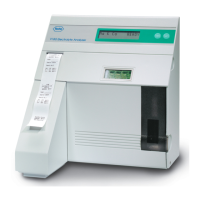Roche Diagnostics
100 Instructions for Use · Version 10.0
7 Measurement 9180 Electrolyte Analyzer
Preanalytics
Acceptable anticoagulants
Electrolyte-balanced heparin anticoagulation salts are recommended for use with
whole blood and plasma samples. These anticoagulant salts have no influence on
electrolyte levels. Electrolyte-balanced sodium heparin can also be used as
anticoagulant in electrolyte analysis. Non-electrolyte-balanced heparin binds
calcium, which can lead to a distortion of the measured values.
Other clot inhibitors, such as EDTA, citrate, oxalate, fluoride, and ammonium-based
materials have significant influence on parameters and should not be used for this
reason.
WARNING
Using sample containers with lithium anticoagulant may lead to incorrect Li
+
measurements
Using sample containers with lithium as an anticoagulant may lead to incorrect QC
measurements and/or incorrect patient results for Li
+
, which may endanger patient lives.
r If you use the analyzer to determine Li
+
results, use lithium-free sample containers.
Sample collection containers
The 9180 Electrolyte Analyzer accepts samples directly from syringes, collection
tubes, sample cups and, with the use of an adapter, from capillary tubes.
WARNING
Using sample containers with lithium anticoagulant may lead to incorrect Li
+
measurements
Using sample containers with lithium as an anticoagulant may lead to incorrect QC
measurements and/or incorrect patient results for Li
+
, which may endanger patient lives.
r If you use the analyzer to determine Li
+
results, use lithium-free sample containers.
q
Do not use sampling containers containing silicone.
Syringes
If using another manufacturer's product with liquid heparin as a clot inhibitor, the
collection container should not be larger than required for the blood volume. This
will minimize the effects of the clot inhibitor on blood thinning.
CAUTION
Using non-heparinized syringes or syringes with liquid heparin may lead to
inaccurate patient results
Non-heparinized syringes and syringes filled with liquid heparin, whose volume exceeds
the sample volume, will not prevent blood clotting in the syringe. Blood clots compromise
the integrity of the blood sample, which may lead to inaccurate patient results.
r Use syringes containing balanced heparin salts.
Capillary tubes
Capillary tubes have to have a minimum volume of 100 μL.
When using stirring rods, remove these rods before inserting the sample in order to
avoid clogging the sample path of the instrument.

